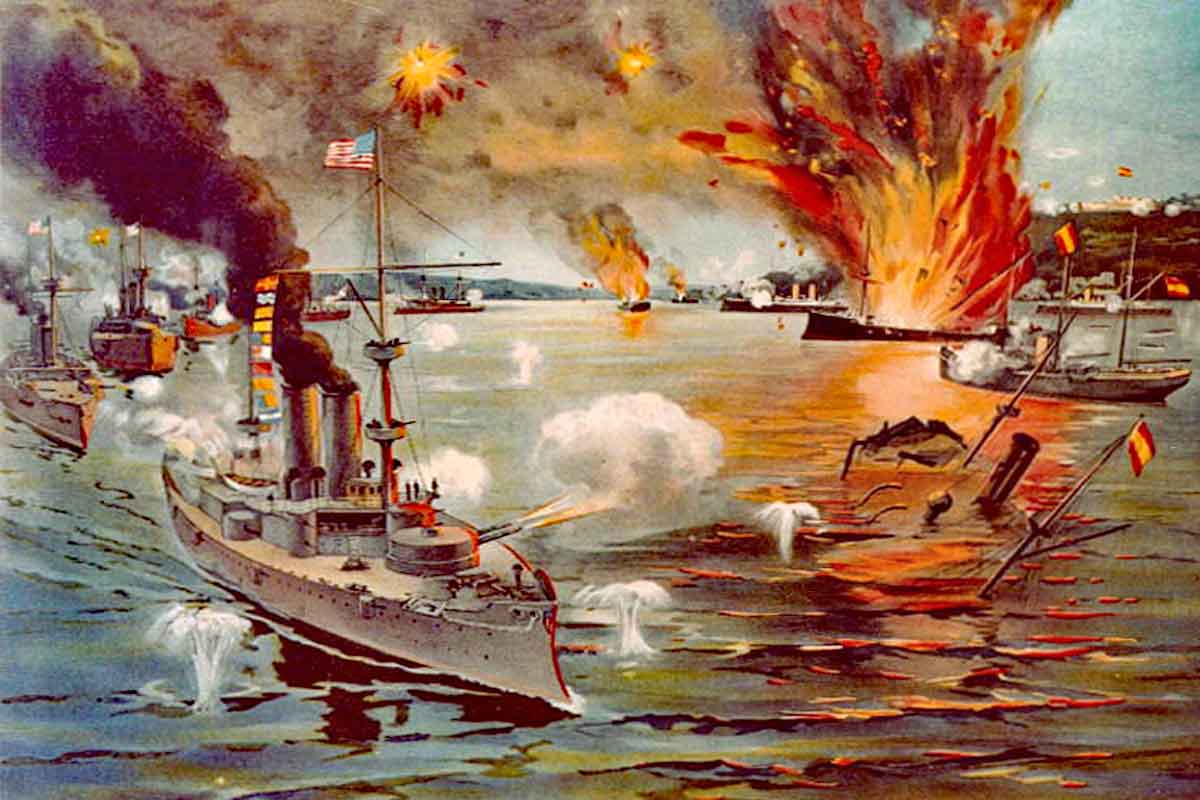
The Spanish-American war started with civil unrest in Cuba, a prominent member of Spain’s “empire.” The Cubans had had enough of the Spanish yoke, and were yearning to be free. At this point America was not involved in the war, although their sympathies were with the Cubans. When a Cuban self-government was set up, apparently in an attempt to stabilize the situation, a riot was started, supposedly by Spanish officials.
Remember the Maine
To protect American interests along with her citizens, the President, William McKinley, sent the U.S.S. Maine to the Cuban shores. However, on February 15, after arriving at Cuba, an explosion occurred which sunk the ship. Although the cause has never been determined satisfactorily, the incident was enough to officially propel the U.S. into the Spanish-American War, a state of war being declared by Congress to have existed since April 21, 1898, the day of the blockade.
Cuba
After receiving authority from Congress to declare war, McKinley sent troops to Cuba to end the civil war. The first act was to blockade Cuba. However, the first battle engaged in during the war wasn’t in Cuba at all. Rather, it occurred in Manila Bay which is located in the Philippines. On the arrival of an order of the Navy Department, a fleet of American ships in Hong-Kong left their moorings in search of Spanish ships. On finding Spanish ships in Manila bay, the two fleets engaged in conflict. The Americans won the naval conflict with a decisive victory, destroying all of their opponent’s ships and suffering no casualties.

In the meantime, a Spanish fleet consisting of seven ships had been blockaded in the harbor, in a bay by the city of Santiago de Cuba. The Americans put all efforts into sinking them. To accomplish this end, it was decided to do both a sea and land attack. But before that could occur, Spanish outposts on shore would have to be captured.
Puerto Rico
On the first of July, the Americans attempted to storm the Spanish outposts. The assault, although difficult, proved successful, and the outpost fell into American hands. The commander of the trapped Spanish fleet, Admiral Cervera, quickly observed that his only options were to surrender or flee. He chose to flee, even though he knew his ships were too slow. In the ensuing naval conflict, all of the Admiral’s ships fell prey to the Americans but one. The captain, seeing that fleeing was useless, had his ship sunk. By July 17, the city of Santiago de Cuba surrendered to the Americans. Eight days later Puerto Rico began to be occupied by the Americans.
By that time, however, the Spanish had perceived the futility of the war. To be sure, there were still useful Spanish armies in Cuba, but they were isolated and couldn’t hope to receive supplies. A battle such as that couldn’t last very long, especially as more American soldiers would arrive. So, Spain decided to discuss terms of surrender. All hostilities ceased on August 12, about three months after the war had started. By December, a peace treaty had been signed, and the Americans had won the Spanish-American war.
Suggestions
- Create a timeline listing the major events before, during, and after the war.
- List the four reasons President McKinley listed for declaring war (see text of his request below).
- Map each of the Spanish holdings at the time of the war.
- Explain Theodore Roosevelt’s role in the Spanish-American War.
Further Investigation
Wreck of the Battleship Maine
(You may want to install an ad blocker before viewing.)
Brief footage from the Library of Congress.
Interactive Timeline
From PBS documentary.
Spanish-American War Chronology
From the Library of Congress.
USS Maine Was Sunk
Simple explanation of the start of the war from the Library of Congress.
President McKinley’s Declaration of War
Original text of his request.
The World of 1898: The Spanish-American War
Background from the Library of Congress.
The Solider
Theodore Roosevelt’s role in the Spanish-American War from the Theodore Roosevelt Association.
Activities
Interactive Map Maker {Free}
Make your own maps of the countries involved.
Essay Questions
Reflective questions for essay or discussion from PBS.
Spanish-American War Quiz
From PBS, great for wrapping up.
Books & Articles
“LXX. The Battle of Manila”
Chapter from The Story of the Great Republic by H.A. Guerber covering the Spanish-American War. Story continues through Chapter LXII.
Forgotten American History: The Spanish-American War by Samuel Blumenfeld
Originally printed in Practical Homeschooling Magazine.

Carry a Big Stick: The Uncommon Heroism of Theodore Roosevelt by George Grant
Biography from the Leaders in Action series. Read our review and suggestions.
The Rough Riders by Theodore Roosevelt
Available as a free download.
Unit Studies & Lesson Plans
America Becomes a World Power
Core Knowledge lesson plan.
The Spanish-American War
Lesson plan from the National Endowment of the Humanities where the student assumes the role of a reporter.
Spanish-American War
An analysis of primary source documents at HistoricalThinkingMatters.org.
The Spanish-American War
Primary Source Set Teacher’s Guide from the Library of Congress.
Printables & Notebooking Pages
Spain
Map for notebook.
Cuba
Map for notebook.
Puerto Rico
Map for notebook.
Philippines
Map for notebook.
The Spanish-American War Notebooking Pages
Simple pages for copywork, narrations, or wrapping up.










You must be logged in to post a comment.